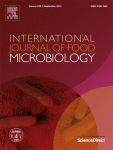Ver ítem
- xmlui.general.dspace_homeCentros e Institutos de InvestigaciónCIA. Centro de Investigaciones de AgroindustriaInstituto de Tecnología de AlimentosArtículos científicosxmlui.ArtifactBrowser.ItemViewer.trail
- Inicio
- Centros e Institutos de Investigación
- CIA. Centro de Investigaciones de Agroindustria
- Instituto de Tecnología de Alimentos
- Artículos científicos
- Ver ítem
Effect of the addition of phytosterols and tocopherols on Streptococcus thermophilus robustness during industrial manufacture and ripening of a functional cheese as evaluated by qPCR and RT-qPCR
Resumen
The quality of functional food products designed for the prevention of degenerative diseases can be affected by the incorporation of bioactive compounds. In many types of cheese, the performance of starter microorganisms is critical for optimal elaboration and for providing potential probiotic benefits. Phytosterols are plant lipophilic triterpenes that have been used for the design of functional dairy products because of their ability to lower serum
[ver mas...]
The quality of functional food products designed for the prevention of degenerative diseases can be affected by the incorporation of bioactive compounds. In many types of cheese, the performance of starter microorganisms is critical for optimal elaboration and for providing potential probiotic benefits. Phytosterols are plant lipophilic triterpenes that have been used for the design of functional dairy products because of their ability to lower serum cholesterol levels in humans. However, their effect on the starter culture behavior during cheesemaking has not yet been studied. Here, we followed DNA and RNA kinetics of the bacterium Streptococcus thermophilus, an extensively used dairy starter with probiotic potential, during industrial production of a functional, semi-soft, reduced-fat cheese containing phytosterol esters and alpha-tocopherol as bioactive compounds. For this purpose, real-time quantitative PCR (qPCR) and reverse transcription-qPCR (RT-qPCR) assays were optimized and applied to samples obtained during the manufacture and ripening of functional and control cheeses. An experimental set-up was used to evaluate the detection threshold of free nucleic acids for extraction protocols based on pelleted microorganisms. To our knowledge, this straight-forward approach provides the first experimental evidence indicating that DNA is not a reliable marker of cell integrity, whereas RNA may constitute a more accurate molecular signature to estimate both bacterial viability and metabolic activity. Compositional analysis revealed that the bioactive molecules were effectively incorporated into the cheese matrix, at levels considered optimal to exert their biological action. The starter S. thermophilus was detected by qPCR and RT-qPCR during cheese production at the industrial level, from at least 30 min after its inoculation until 81 days of ripening, supporting the possible role of this species in shaping organoleptic profiles. We also showed for the first time that the addition of phytosterols at functional concentrations, not only did not affect starter performance but also correlated with a significant increase in target DNA and cDNA levels in most of the time points evaluated throughout cheesemaking. Therefore, these findings suggest that the growth and metabolism of S. thermophilus may be enhanced by the incorporation of these biologically active molecules during cheese production, providing important information for the industrial design of novel fermented foods.
[Cerrar]

Fuente
International journal of food microbiology 232 : 117-125. (September 2016)
Fecha
2016-09
ISSN
0168-1605 (Print)
1879-3460 (Online)
1879-3460 (Online)
Formato
pdf
Tipo de documento
artículo
Palabras Claves
Derechos de acceso
Restringido
 Excepto donde se diga explicitamente, este item se publica bajo la siguiente descripción: Creative Commons Attribution-NonCommercial-ShareAlike 2.5 Unported (CC BY-NC-SA 2.5)
Excepto donde se diga explicitamente, este item se publica bajo la siguiente descripción: Creative Commons Attribution-NonCommercial-ShareAlike 2.5 Unported (CC BY-NC-SA 2.5)

